Few topics get backcountry paddlers more fired up than debating the ethics of burning garbage on trip, or contesting the best way to bear-proof your camp. Mention canoeing and firearms in the same breath, and some paddlers are apt to go ballistic. Ditto for sharing hidden gems on social media, or practicing survival bushcraft on public land. Should wearing a PFD be optional or mandatory? Does your groundsheet belong under your tent, or inside?
Explore paddling’s most enduring controversies, get advice from the experts, and then decide where you stand on these crucial issues.
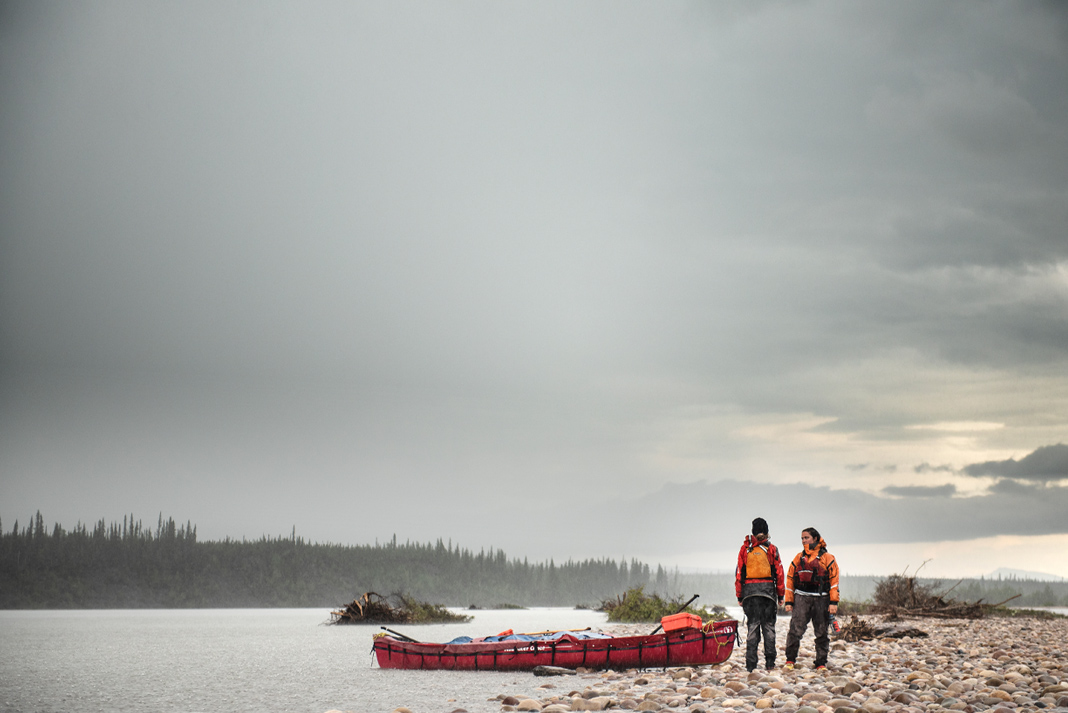
Controversy: Burning Garbage
Are there exceptions to the pack-it-in-pack-it-out rule?
Survey any group of backcountry paddlers, and the subject of burning garbage is sure to be a hot topic. Hard-line LNT (Leave No Trace) followers advocate packing out everything you pack in, while many wilderness users still adopt an “if it burns, burn it” attitude. Taking the middle ground, guidebook authors and veteran expedition paddlers Laurel Archer and Cliff Jacobson suggest burning food scraps and paper waste in a small, hot fire while observing minimum-impact camping practices.
Location
First, consider whether it’s safe (and legal) to start a fire. Check fire danger ratings and open-fire bans for the area you will be paddling. Also, check local camping regulations; for example, in Minnesota’s Boundary Waters Canoe Area Wilderness the burning of any garbage is prohibited. You’ll need a compact wood-burning stove to contain compost and rubbish fires in fragile ecosystems or on remote northern trips above treeline.
Trip Length
Campers on both sides of the debate cite the length of trip as a deciding factor. If you are only out for a few days, repackage food so scraps and trash are minimal and easily packed out. Waste management on extended trips is more challenging, argues Jacobson. “On a long trip, you will accumulate quite a bit of paper and plastic trash, some of which may contain grease or remnants of food attractive to animals. If you don’t burn this stuff, you’re asking for trouble!”
Bring the Heat
Any low-impact fire should burn hot enough to leave only fine, white ash—this includes your watermelon rinds and spaghetti leftovers. A well-built campfire can reach temperatures exceeding 600°C (1,112°F). This is approaching the threshold (650°C/1,200°F) recommended by the Nunavut Department of Environment, where burning household waste is practiced in remote communities. Generally, if your combusting rubbish produces visible smoke, your fire is not hot enough.
Dirty Deeds
A U.S. Forest Service study found significant traces of heavy metals and other toxins in the ash of campfires used to burn plastics, tin and aluminum foils. Rather than “burning clean” cans and foil, wash and pack out these items. Never burn plastics containing chlorine—most commonly PVC and Styrenes (numbers 3 and 6, respectively, in the plastic ID code)—which produces highly toxic, bioaccumulative dioxins and furans.
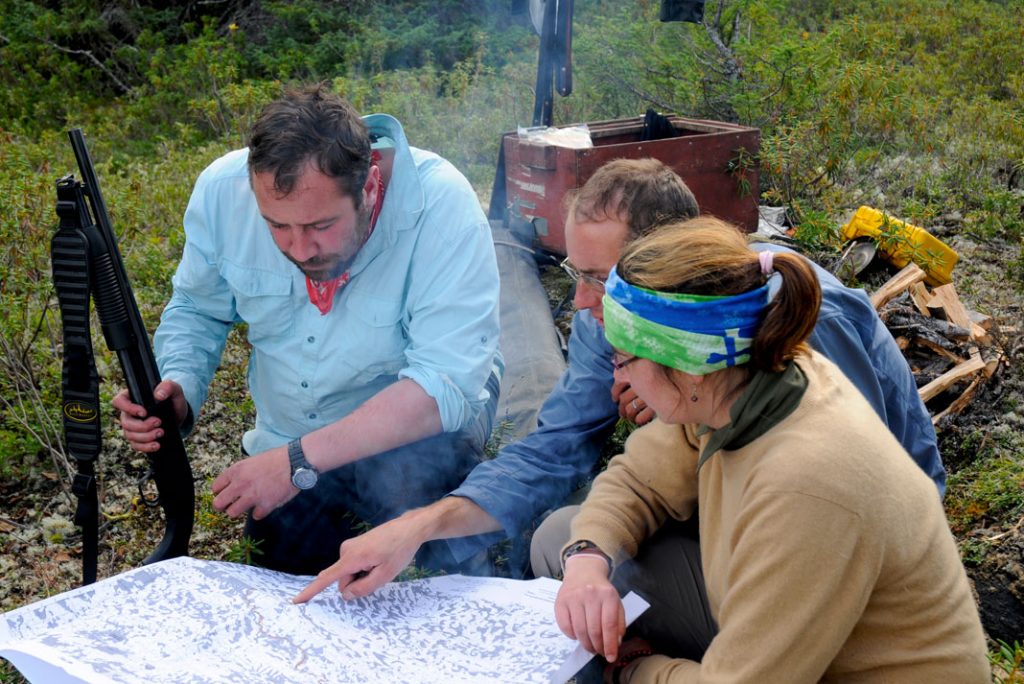
Controversy: Bringing a Gun
Does a firearm make you safer in the backcountry?
Last summer, two American canoeists made international news when they were rescued from a barrenlands river in the Northwest Territories after a grizzly bear destroyed their tent and canoe. One of the wildlife officers involved in the rescue told reporters the couple seemed to do everything right—other than not having a firearm with them. Yet there’s ample evidence to suggest if they had, the outcome could have been far worse.
Bear Spray vs. Bullets
In Bear Attacks: Their Causes and Avoidance, Canadian bear biologist Stephen Herrero found a person’s chance of incurring serious injury from a charging grizzly doubles when bullets are fired versus when bear spray is used. While his research didn’t reveal a single case where spraying the bear with pepper made it more aggressive, evidence suggests shooting a bear can escalate the seriousness of an attack. These findings are echoed by a U.S. Fish & Wildlife Service review of human-bear encounters since 1992. “Even a skilled marksman with steady nerves may have a slim chance of deterring a bear attack with a gun,” concludes the report.
Other Considerations
“I stopped taking a gun on trip because of the weight and general nuisance trying to keep it from rusting,” writes author and wilderness guide, Hap Wilson. Cans of bear spray require no maintenance and are compact enough to be carried by each member of your party. “Leave guns at home if you are not well practiced with them, or if your friends don’t feel comfortable around them,” advises Cliff Jacobson. Know the law: Firearms are illegal in many parks and recreation areas.
Exception
Many paddlers, including Jacobson, choose to carry a shotgun or high-powered rifle for trips to Hudson Bay. Unlike the vast majority of black bear and grizzly encounters, which are defensive in nature rather than predatory, polar bears may view humans as a potential meal.
Whatever you do…
Don’t handle firearms without appropriate training and licensing. Plinking a few cans in the back forty doesn’t qualify you to bring a gun into the backcountry. In polar bear country, it’s safer to hire a qualified, armed “bear monitor” to accompany your group—a measure required by some northern parks.
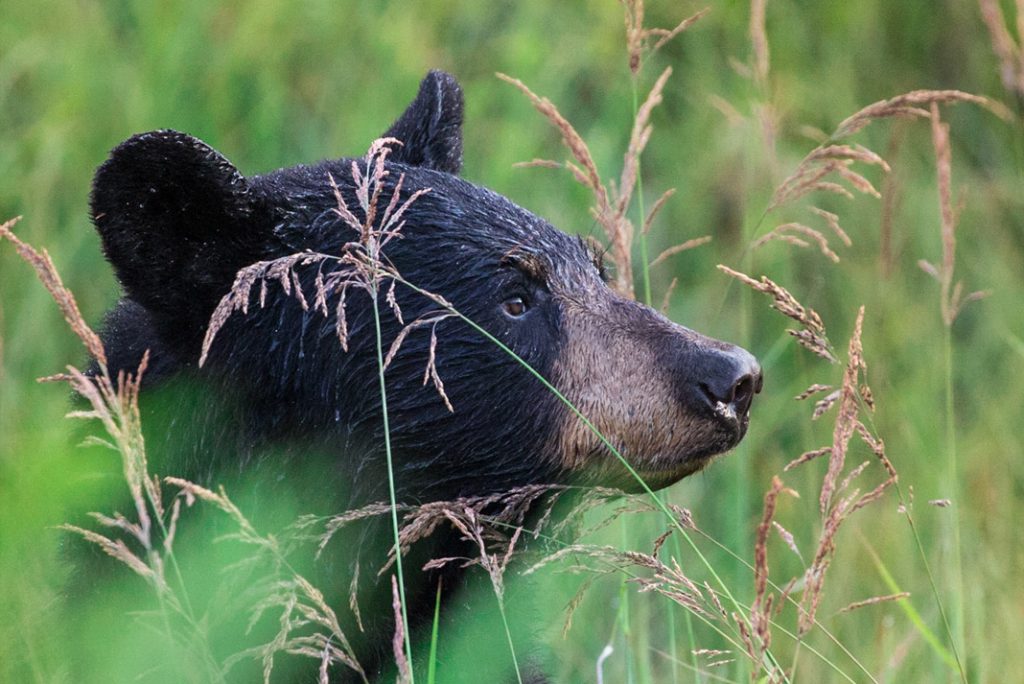
Controversy: Bear Proofing
To hang or not to hang?
What’s the best way to bear-proof your food at camp? Don’t get hung up on one way of doing things, say the experts; outsmarting bears means adapting to the environment and following a few simple rules.
Many camping books, parks and publications advise hanging your food packs from a rope suspended between two trees or from a sturdy tree limb out of a bear’s reach—typically 12 to 15 feet (4 meters) off the ground and 8 to 10 feet (3 meters) from the tree trunk. Canoe guide Hap Wilson derides such tree hoists as “bear piñatas.” Expedition paddler Cliff Jacobson agrees, “In my experience, the outfitter- and government-recommended rigmarole of caching food packs in trees is a waste of time and energy. Most campsites don’t have a lot of good, high bear trees. There’s often only one suitable tree that’s used by everyone. Once a bear has discovered this special tree, he’ll tear apart whatever you hang in it.”
More Options
Alternatives to tree hangs rely on the idea that if bears and other animals can’t smell your food, they won’t get into it. “On the barrens, there are no trees; you have to cache your food on the ground,” points out Jacobson. Seal all food, pots/pans, eating utensils, garbage and toiletries in scent-proof sacks or bear-resistant canisters and stash these at least 300 feet (100 meters) from your sleeping and cooking areas. Standard blue canoe barrels—while more critter-proof than a canvas pack—are by no means bear-proof. Park staff in popular areas like the Boundary Waters report some bears now associate blue barrels as a source of food. Many touring kayakers store drybags of food in their boats’ watertight hatches, but consider this: if a bear does find your food, your kayak is history.
Whatever you do…
Keeping a clean, odor-free campsite and stashing food securely is done for the bear’s protection, not your breakfast’s. Once a bear becomes conditioned to human food sources, it’s potentially dangerous and must be relocated or destroyed. In 2017, conservation officers in British Columbia killed nearly 500 habituated and food-conditioned bears.
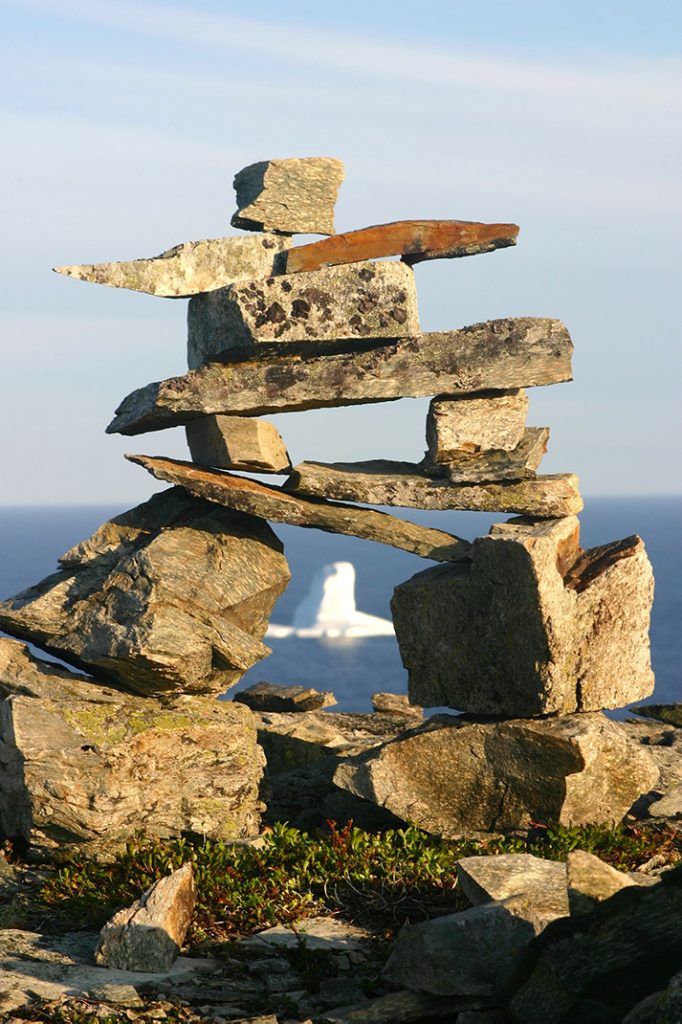
Controversy: Cairn-kicking
When is a cairn not a cairn?
The issue of building cairns in the backcountry may seem trivial, but there’s more at stake than a little rock geometry. Cairn-builders see themselves as helpful (marking a portage trail, for example) or harmless (leaving a stone figure to greet the next campers at a site). Those opposed have taken up cairn-kicking—the practice of toppling and scattering these stone homunculi—to better preserve the wilderness experience. Both are problematic; here’s why:
Location
On the tundra and in other remote areas, cairns may be centuries old, built by Indigenous peoples as way-markers or direction indicators. It’s both disrespectful and dangerous to alter these traditional structures—either by removing or adding rocks. Park staff and trail builders also use cairns to mark routes in treeless areas. Knocking these down or constructing your own in the same area could misdirect other backcountry users.
A Matter of Principle
Guidebook author Laurel Archer cites this principle of low-impact travel practices and ethics: “Don’t change the environment. Leaving rock cairns by the portage trail may seem like a grand and even helpful idea, but maybe the person behind you wants to find his or her way just like you did.”
Tear it Down
If you can’t resist building your own structure, do so on a beach and disperse the stones before you leave so the site remains as wild for the next visitor.
Be Considerate of Others
Moving rocks disturbs natural ecosystems—salamanders, insects, snakes and spiders may be sheltering beneath, and the delicate lichens on those stones may have taken hundreds of years to grow.
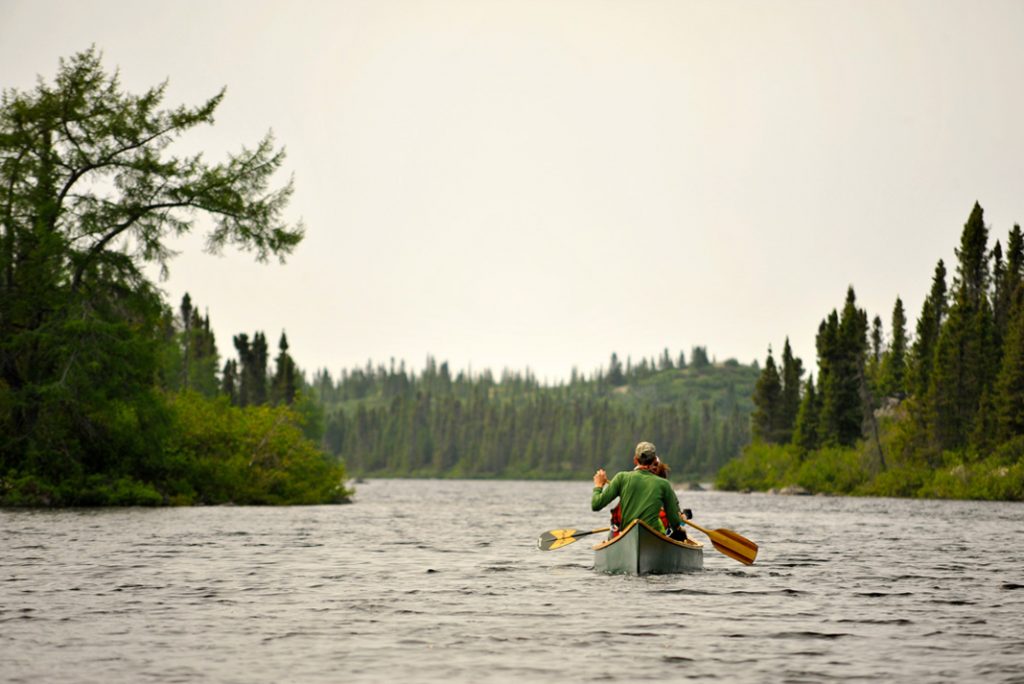
Controversy: Wearing Your PFD
On your body or in your boat?
In both the U.S. and Canada, the law requires carrying a life jacket or PFD for each person in your craft. Wearing it seems like a no-brainer, yet still 15 percent of participants surveyed in the Outdoor Foundation’s 2019 Special Report on Paddlesports & Safety feel personal flotation devices are generally unnecessary. That’s roughly 3.4 million paddlers taking needless risk on the water.
Trust the Numbers
The report notes “while paddling activities appear low-risk, an alarmingly high 29 percent of incidents reported from 2015 to 2017 resulted in a fatality.” Data published by the U.S. Coast Guard for the same period recorded 758 paddlesports deaths, with 79 percent involving drowning. Of those drowning victims, 74 percent were not wearing personal flotation devices. In a 20-year study published in 2016, the Canadian Red Cross estimated 85 percent of boating deaths were preventable if victims had been wearing life jackets.
Fair Weather Fallacies
More than three-quarters of reported paddlesports incidents occur when there is good visibility and benign water conditions.
Whatever you do…
Always wear a coast guard-approved life jacket or PFD. United States federal law requires children under 13 to do so. For the rest of us, it’s the smart choice. Modern, paddler-specific vests are comfortable to wear for all ages, and low-profile inflatable models provide a lightweight option for hotter climates. Learn more at www.saferpaddling.com.
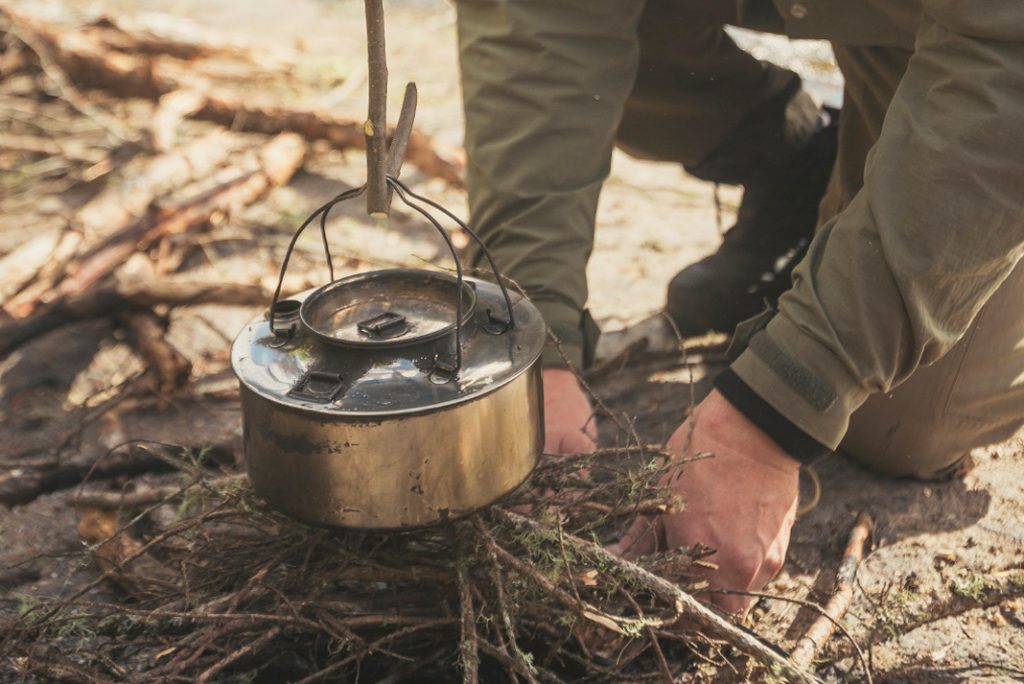
Controversy: Bushcraft
Timeless skills or thoughtless thrills?
It seems wherever you look these days, there’s a wilderness survival series or Internet vlogger showing off his self-proclaimed proficiency in the woods. That’s led to a resurging interest in bushcraft, the use of traditional skills and available natural resources to live comfortably in the outdoor environment. Skeptics argue today’s brand of popular bushcraft is incompatible with low-impact practices, or worse.
The Good…
Bushcrafters like Ray Mears—founder of Britain’s Woodlore School of Wilderness Bushcraft—demonstrates these skills in a thoughtful, ecologically sustainable way. “Bushcraft is the term I employ to describe a deeper knowledge of the wild and of nature,” explains Mears in the film, We Belong To It. “It is a huge tree that branches out in many directions to botany, zoology, craftwork, outdoor leadership and countless other divisions. Everyone who visits wild places will benefit from bushcraft knowledge.”
The Bad and the Ugly
Pointless pillaging results when wannabe bushcrafters head into the woods without the requisite knowledge. In a forum debating bushcraft versus Leave No Trace on the outdoor site Trailspace.com, users highlighted some common offenses: using a hatchet or saw to cut down live trees, “especially when done for a brief Daniel Boone moment,” and creating additional fire pits at a campsite with an existing fire ring. One incensed camper described stumbling across such a setup in Tennessee’s Citico Creek Wilderness: “It looked like a weekend wet dream to emulate TV idiots.”
Location & Impact
In a time of diminishing wilderness and increasing use, how can bushcraft be reconciled with the low-impact guidelines established to protect these places? Christian Noble, founder of MasterWoodsman.com, argues both sides need better education. “There is no such thing as leaving no trace. No matter what you do, you will be making an impact,” he contends. Examples of low-impact bushcraft are using downed wood rather than harvesting live trees, and practicing responsible, low-trace fire building. Bushcraft should be practiced away from any areas experiencing heavy use, and is not permitted in many wilderness areas or national parks.
Whatever you do…
Don’t leave your ad-hoc construction for others to admire—especially if your idea of bushcraft involves miles of yellow utility rope and acres of blue poly tarp. Dismantle and pack out.
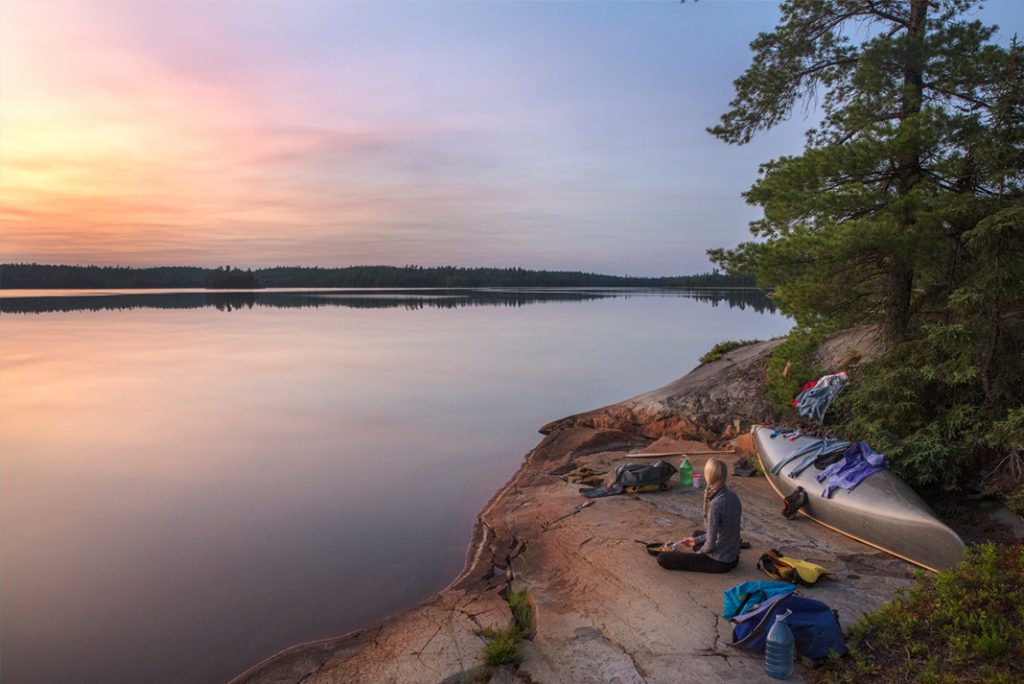
Controversy: Campsite Permits
Does backcountry site selection put paddlers at risk?
Depending on where you paddle, your backcountry permit may allow first-come camping on any available site, secure camping on a particular lake, or reserve a specific campsite for your group. While each system has its pros and cons, some backcountry paddlers believe site-specific permits come at the cost of spontaneity and, more importantly, safety.
Risk vs. Reward
Site-specific permits can offer paddlers peace of mind. You can plan a longer day or enjoy a late start, knowing “your” site will be vacant when you arrive. This system takes the guesswork (and the fun) out of campsite selection. But many scenarios could prompt paddlers to pull off the water earlier than anticipated. Declining or dangerous weather conditions—such as strong winds, poor visibility in fog, and thunderstorms—are especially problematic in exposed coastal areas with few safe landings. Injury, exhaustion or upsetting in cold water can curtail your plans no matter where you’re paddling. In such cases, pushing on to reach “your” campsite puts everyone at unnecessary risk.
What’s the Alternative?
Different parks have different approaches to managing backcountry use. Paddlers in Ontario’s provincial parks must negotiate all three systems: site-specific permits are issued in busy southern parks like Kawartha Highlands and The Massasauga; Algonquin and Killarney employ lake-specific permits; and canoeists on the French or Spanish rivers enjoy the freedom of first-come, first-served camping. While it makes sense parks with heavier use employ a more rigid approach than remote, lightly used areas—that isn’t always the case.
Before Booking Campsites
Be realistic about how far you can (or want to) travel in a day. A more conservative distance or route allows time for inclement conditions and rest days, without falling behind schedule.
Whatever you do…
Don’t keep paddling when it isn’t safe to do so, and don’t turn away a group who arrives at your site in treacherous weather.
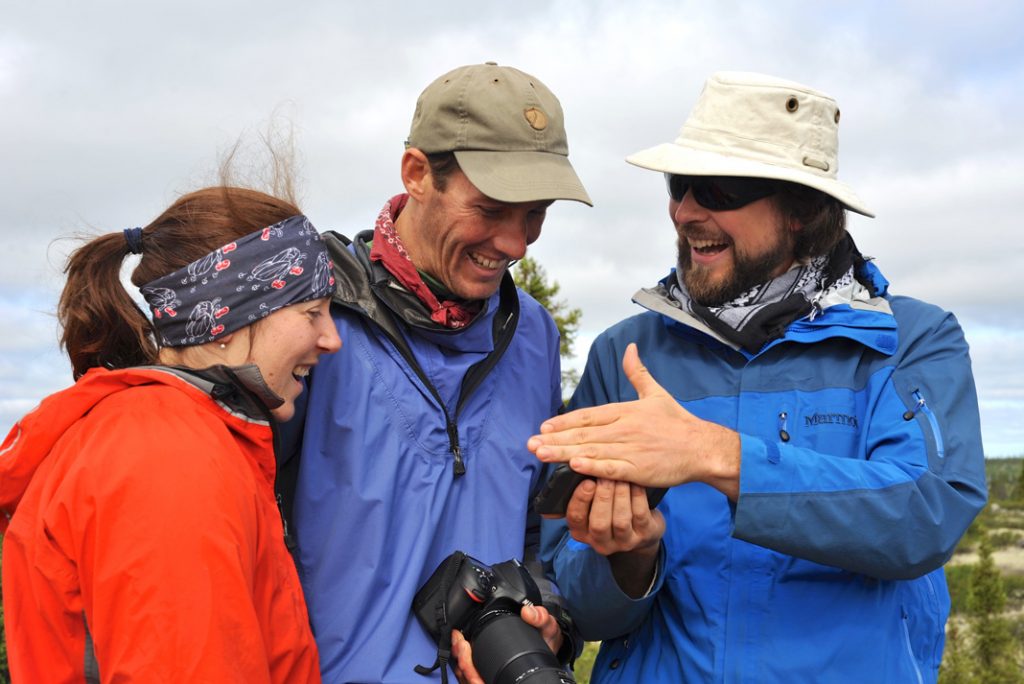
Controversy: Insta-damned
Is social media killing the backcountry?
Sharing a wanderlust-inspiring selfie on social media is hard to resist, but posts revealing too much about secluded lakes and obscure routes are harming the very places we love (paddlingmag.com/0078). In 2017, a group calling themselves Hikers for an 8th Principle launched a campaign urging the Leave No Trace Center for Outdoor Ethics to update their guidelines to address a growing 21st-century issue: Rapidly increased traffic to vulnerable places, driven by social media posts.
Finding a Balance
It’s no surprise there’s a heated debate around this issue, with social influencers, media outlets like The New York Times and Outside, conservation groups, tourism boards and users of all stripes joining the conversation. Those opposed to the group’s message say it amounts to elitist censorship. Supporters—among them users and land managers who have witnessed the damage resulting when a location goes viral—say it’s about striking a balance. Calling for “obscurity, not secrecy” proponents say sharing your experiences with friends and followers is fine, as long as you do it in a socially and environmentally responsible way.
The New Rules
Popular Instagram users are moving away from geotagging specific spots, and so should you. Avoid a stampede by naming just the park or region, rather than disclosing an exact lake, canoe route or fantastic campsite. Social media guidelines introduced by the LNT Center in 2018 also ask posters to be mindful of what their images portray—consider what your photo may encourage others to do, and set a good example.
Whatever you do…
Don’t give too much away. Geotagging images or providing turn-by-turn directions not only promotes overuse of fragile ecosystems, it also deprives other visitors of the sense of discovery that makes backcountry adventures so special.
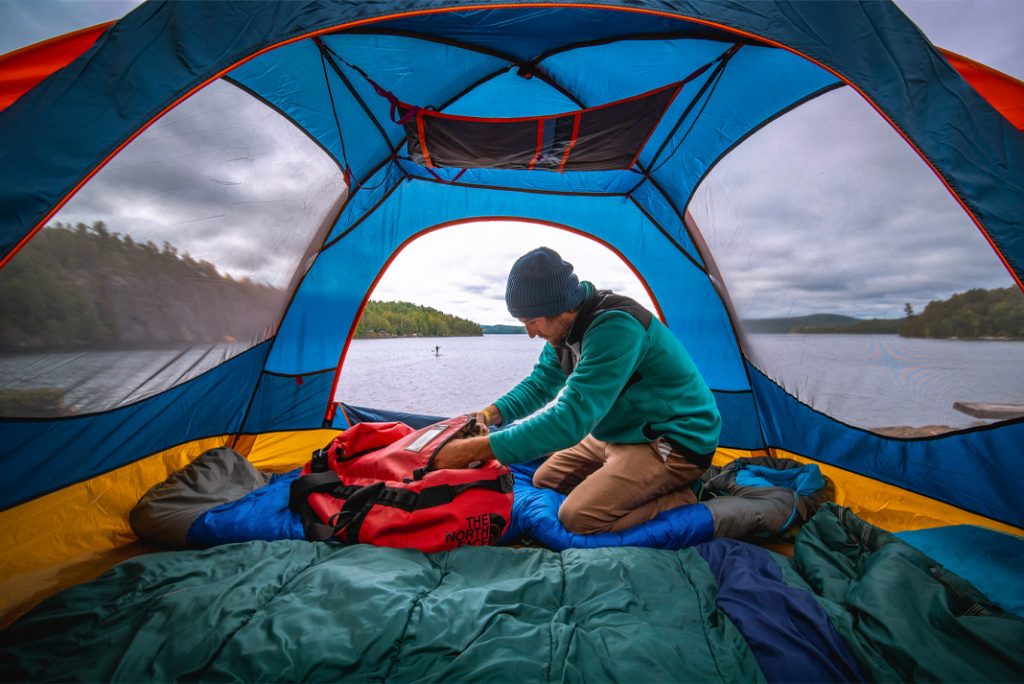
Controversy: Innie vs. Outie
Should a groundsheet go inside the tent or underneath?
Most tent manufacturers sell a waterproof nylon footprint accessory for use under their tents. The footprint protects the interior from ground moisture and the bottom of the tent from abrasion. However, some argue optimal waterproofing is achieved by simply lining the interior of the tent with a plastic groundsheet.
The Dry Goods
A vocal proponent of the innie method, Cliff Jacobson is quick to say those who have camped out a lot and in a lot of rain understand why groundsheets should go inside. “Old ideas die hard. A ground cloth outside is the same as pitching the tent on a slab of concrete. It won’t keep you dry when the ground is flooded. Water will get in between the footprint and the tent and get inside.” Jacobson has camped out for thousands of nights and claims he hasn’t been wet in his tent since he was 12 years old.
Don’t Be A Wet Blanket
Instead of shelling out an additional $70 for a branded footprint accessory, Jacobson suggests cheap, clear hardware store plastic, about a foot larger than the tent all around. “You run the plastic up the sidewalls, like a bathtub,” he says. A benefit to the innie method is dirt and debris inside the tent are easily removed by pulling out the groundsheet, and so long as the topside of the groundsheet stays dry, you’ll have a dry floor at the next camp.
Some ultralight sil-nylon tents feel so delicate they should never directly touch the earth, but Jacobson argues zippers and UV proofing will fail on most tents well before the floor.
Whatever you do…
Know that if a river runs through it, no footprint will keep the interior of your tent dry. Campsite selection is the first step in waterproofing any shelter. However, “If you get days and days of rain, the only thing that will save you is a groundsheet in the tent,” declares Jacobson. —KP
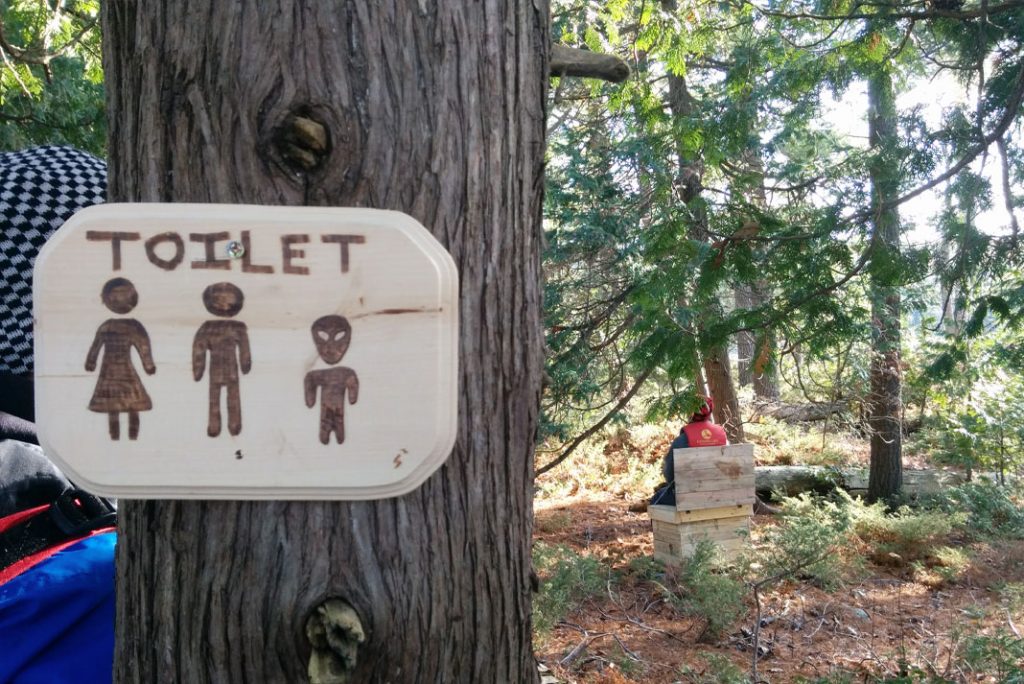
Controversy: Potty Talk
What is the correct name for a backcountry toilet?
Which Way to the…?
The humble pit toilet may be known variously as a treasure chest, thunderbox, KYBO (Keep Your Bowels Open), squatty potty, privy, vault, boom box, long drop or latrine. To avoid controversy—and get where you need to go—learn the local dialect.
This article was first published in Paddling Magazine Issue 62. Subscribe to Paddling Magazine’s print and digital editions here, or browse the archives here.
Looks like rain tonight: innie or outie? | Photo: Francois Leger-Savard



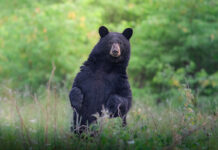


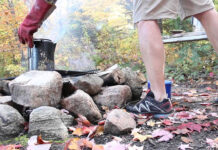
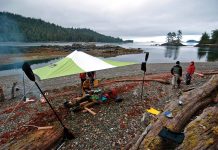

This is the best, most on-target article on PADDLER’S DEBATES I’ve read. The author has been there, done that and knows what she’s talking about. Superbly written. Terrific job, Virginia! A few thoughts regarding firearms on canoe trips. If you are canoeing in polar bear country (Hudson Bay) and all you have is pepper spray, best hope the wind isn’t blowing in your face if you have to spray. If you’re on the tundra it may well be! If you carry a gun, and have to shoot, it will probably be at a distance of around 60 feet with a bear likely hurling towards you. You’ll get one shot, two only if you’re very lucky. You’d better not miss, which requires extensive practice at home, before the trip. Failing this, leave the gun at home! Hap Wilson’s point about rusty guns on canoe trips is accurate. However, there are waterproof gun cases–a must for canoeing. Seldom mentioned is that a bear gun should be loaded with proven dangerous game bullets or slugs, not typical “deer hunting ammo you buy at hardware stores”. The difference is profound! And be aware that civilian ammo is NOT reliably waterproof (best to paint primer pockets and rifle cartridge case necks with nail polish).
You forgot the rafter’s potty: the “groover!”
I am a sea kayaker, and for 20 years took parties of kayakers on trips up to 6 weeks duration on the BC and SE Alaska coasts, keeping mainly to the outside of the island chains. I go along with much of what has been written above. Although, in the main, participants were soldiers on what the British Army deem Adventure training, we were not allowed to take weapons, however we were allowed to carry flares, so this was our answer to the bear problem, plus having one pepper spray. We used the beach as our toilet area (so solids would be washed away by the tide, or eaten by creatures living in the intertidal zone. Much of this area does not have trees suitable for hanging foodstuffs in trees, so we used the watertight hatches as storage space. Fish we caught en route and ensured all gutting, cooking and eating was carried well away from the tents, and again, the tents kept well away from the kayaks. I can only recall two occasions when bears walked through our camp. Finally, in our PFDs we kept survival items such as flares, matches, tinned biscuits, torch, whistle, and radios/PLBs, survival blanket, stored in the PLB, and these were heavy, but still floated. We did not wear them as a matter of course as their weight and bulk made them difficult to paddle, however they were strapped to the back deck and were grabbable at a moments notice or when paddling through the surf at a moments notice. Campcraft and living in such an environment was taught at the start of each trip so that harmony reigned throughout the trips
Nice writing Virginia, and spot on. One point on bear spray, you may not be allowed to carry it on a fly-in plane in some areas, but others let you and suggest/demand that you put the spray into a container with a secure lid (a wide-mouthed water bottle can work). This minimizes the chance that the spray might burst out inside the cockpit of the bush plane. Also, I think the media needs to be more assertive in covering some of these topics and provide more info to the level you did in this article. There are a lot of egos to be reined in, even in the world of back-country purists. Cliff’s usually has good, experiential tips, too. Take all the bushcraft stuff with a grain of salt. Become self-reliant for your own well-being, not so you can emulate Jeremiah Johnson.
A very informative and well-balanced article and I learned a few things (e.g. the heavy metals/toxins in campfire ash when you burn foil and such; should have thought of it but hadn’t. I’ll field strip such materials out of supplies before departure even more rigorously from now on).
On the issue of firearms and bear spray, I generally agree with the overall conclusions, will second Tom’s note about transporting pepper spray, and add two considerations.
On a 2013 solo trip across the Brooks Range, linking the Noatak and Kobuk via Angiaak Pass, I was unable to bring pepper spray on the flight from Montreal to Fairbanks. I arrived in Fairbanks long after stores had closed and was departing for Coldfoot before they opened. The bush plane operator assured me that they had pepper that I could borrow, but in the hubbub of departure, it was forgotten. Humans.
Moreover, and the first of my two points, later experience on the journey proved that what you are used to and trained on is of the utmost importance. I started shooting with a lever-action 30-30 at age nine and used it in turkey shoot competitions and hunting for all of my formative years thereafter. I have kept up some practice since, but far less as I don’t hunt anymore. However, as it turns out, I am still rather reflexive in employing a lever-action rifle. I had, at Cliff’s suggestion and example, a Marlin .45-70 lever-action Guide-Gun for that trip and was charged from behind by a grizzly during my first day afloat on the Reed River coming out of Angiaak Pass. Pepper spray never entered my mind. Now, of course, one could pointedly train with pepper spray to counter that deficiency, and having only pepper spray as Hap Wilson suggests (and I which I usually do and always do if firearms were not allowed – such as our recent trip across the Ungava Peninsula which started in Tursujuq National Park) would have forced the decision very effectively, but even with seven and half years of reflection, I am convinced that if I’d had a choice, I would have still chosen the rifle in the hot split second after seeing a full-grown grizzly barrelling at me (I was in less than a foot of water). It was a matter of familiarity and the seeming urgency of the problem. For the record, I am somewhat sure that pepper might have worked too :-).
The second point is not one that has any place in considerations of public policy or generalized advice. However, it was a critical factor in my encounter and, I suspect, would be a common factor in many such, though it obviously is not to be relied upon. Adrenaline. The absurdly slow, slow-motion in which the encounter seemed to occur, gave me ample time to plan and, I am very sure, heightened my capabilities far beyond my normal. That is why I pointedly and calmly decided to fire a warning round past his left ear instead of a killing round through his chest (which, I had noted with great relief, was open, though I also noted that his lower jaw and muzzle sometimes blocked it). He came to a comedic stop (imagine 600-lbs. of grizzly trying to stop on a dime in shallow water and gravel) about 20 ft. from the bow of my canoe.
I read Herrara’s paper before departing on our Noatak trip in 2012 and some issues with the data occurred to me. The most salient one that I recall was the oft-repeated (as it is here) disparity between positive outcomes using pepper and firearms. My reading suggested that there may have been an inherent bias in the data. The firearms incidents were usually dealing with already highly aggressive and/or charging bears (such as my encounter) whereas the pepper incidents were commonly dealing with curious bears. That could skew the negative outcome numbers significantly.
Thanks for the article!
Be very careful when testing Bear spray…don’t ask me how I found out…suffice to say,would not want to be a sprayed bear..
And if you were ever to spray even a little in a tent or car…may God help you..
Great article,enjoyable and informative…guess I gotta wear a PFD from now on..eff!
Yea been a year and Livin in me tent I agree with cliff site location huge, sun kills tents and you, But rain fly in tent I agree also zippers fail, rain flys break down, and there a fine line with warranty’s , regular usage ain’t the same as extreme usage big dam grey area when gear fails.